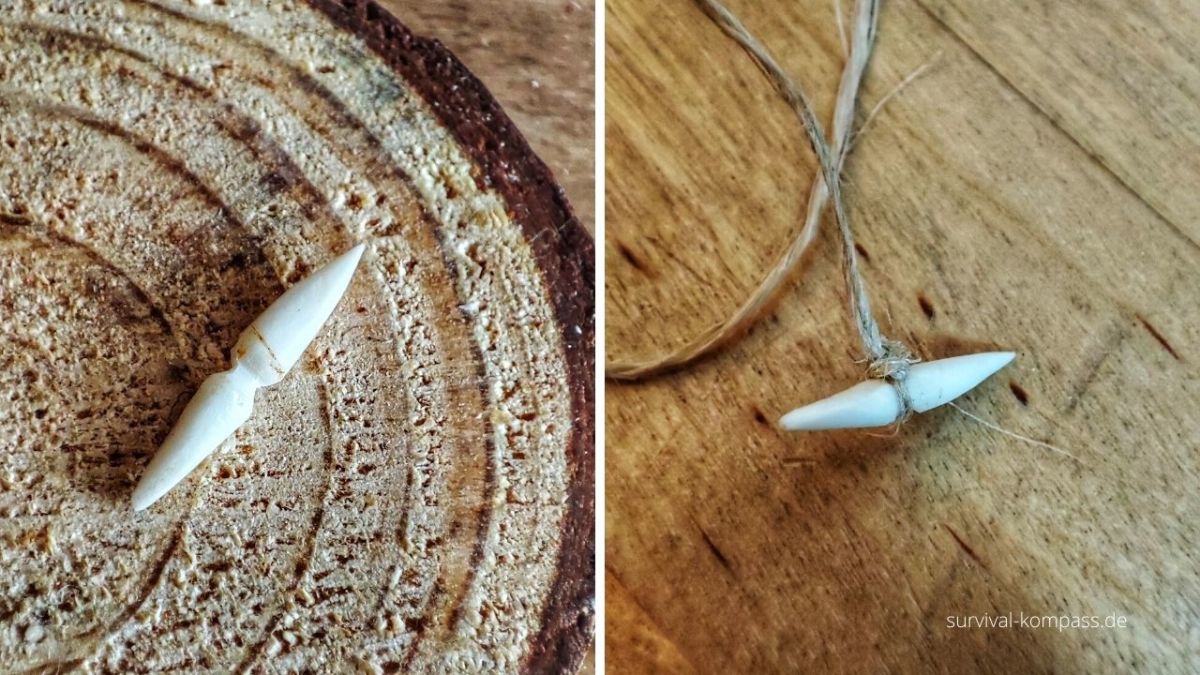
fishing hook
Noun
Meaning
A fishing hook is a small, curved device made of metal or other materials, designed to catch fish by piercing their mouths or bodies. It is an essential tool in the world of survival, bushcraft, and outdoor activities such as camping, hiking, and wilderness exploration.
When it comes to survival, a fishing hook can be a lifesaver, providing a means to catch food in a survival situation. It allows you to fish in rivers, lakes, or even the ocean, increasing your chances of finding sustenance in the wild.
Whether you are an experienced angler or a beginner in the world of fishing, understanding the different types of fishing hooks and their uses is crucial for successful fishing and survival in the great outdoors.

Examples
„I love going fishing in the wilderness. It's such a peaceful and rewarding activity.“
„Last weekend, I caught a huge fish using my trusty fishing hook. It was a thrilling experience!“
„When you're out in the wild, having a fishing hook in your survival kit is essential. It can help you catch food and sustain yourself.“
„My friend and I were discussing our favorite fishing techniques, and we both agreed that using a fishing hook is the most effective way to catch fish.“
„During my last camping trip, I forgot to pack a fishing hook, and I had to improvise by making one from a piece of wire. It worked surprisingly well!“
„If you're new to fishing, I recommend starting with a simple fishing hook. It's easy to use and perfect for beginners.“
Origin
The word "fishing hook" originates from the Old English word "hoc," which can be traced back to the Proto-Germanic word "hokaz." This word has its roots in the Proto-Indo-European language, specifically the word "keg," meaning "to bend" or "to hook."
Throughout history, fishing hooks have been essential tools for catching fish. They have evolved over time, with early hooks made from bone, wood, or other natural materials. As civilizations advanced, hooks were crafted from metals such as bronze, iron, and steel.
Today, fishing hooks come in various shapes, sizes, and materials, each designed for specific fishing techniques and target species. They are an integral part of angling and are used by recreational and professional fishermen worldwide.
Synonyms
Angling hook, Fish hook, Bait hook, Lure hook, Tackle hook, Fishing lure, Fishing tackle, Fishing gear
Antonyms
Fishing hook: release, Let go, Unhook, Detach, Disconnect, Separate, Unfasten, Undo
Relatives
Fishing line, Bait, Tackle box, Fishing rod, Fishing reel, Fishing net, Fishing lure, Fishing sinker
Historical and cultural importance
The fishing hook has a rich historical and cultural significance that spans across different civilizations and time periods. Dating back thousands of years, fishing hooks have been essential tools for human survival and sustenance.
In ancient times, fishing hooks were crafted from various materials such as bone, wood, and metal. They were used by indigenous tribes and early civilizations to catch fish for food and trade. The design and construction of fishing hooks varied greatly depending on the region and the available resources.
For example, Native American tribes in North America used bone or antler hooks, while ancient Egyptians used hooks made of bronze or copper. In Japan, traditional fishing hooks called "temomi" were meticulously handcrafted using silk thread and horsehair.
Throughout history, fishing hooks have also held cultural significance beyond their practical use. In many societies, fishing was not only a means of survival but also a symbol of skill, patience, and connection with nature. Fishing hooks were often adorned with intricate carvings or decorative elements, reflecting the cultural values and beliefs of the people who used them.
Today, fishing hooks continue to play a vital role in recreational and commercial fishing. Modern fishing hooks are typically made of high-quality steel or carbon fiber, designed to be strong, sharp, and durable. While the materials and techniques have evolved, the fundamental purpose of the fishing hook remains the same – to catch fish and provide sustenance.
Understanding the historical and cultural significance of fishing hooks helps us appreciate the deep-rooted connection between humans and the natural world, as well as the ingenuity and resourcefulness of our ancestors in their quest for survival.
More information about the term fishing hook
Fishing Hook: A Vital Tool for Survival
When it comes to survival in the wilderness, one tool that should never be overlooked is the fishing hook. This small but essential piece of equipment can mean the difference between going hungry and catching a meal. In this article, we will explore the importance of the fishing hook in survival situations and discuss its various types and uses.
The Importance of a Fishing Hook
When you find yourself in a survival situation, food becomes a top priority. While foraging for edible plants and hunting small game are viable options, fishing can provide a consistent and reliable source of sustenance. A fishing hook allows you to catch fish, which are rich in protein and essential nutrients, ensuring your survival in the wild.
Furthermore, fishing can be a passive activity, allowing you to conserve energy while waiting for a bite. This makes it an ideal method for obtaining food when resources are scarce or when you need to focus on other survival tasks.
Types of Fishing Hooks
There are various types of fishing hooks available, each designed for specific fishing techniques and target species. Some common types include:
- J-hooks: These hooks have a classic "J" shape and are versatile for catching a wide range of fish.
- Circle hooks: Designed to reduce the chances of gut-hooking fish, circle hooks are ideal for catch-and-release fishing.
- Treble hooks: Featuring three hooks in one, treble hooks are commonly used for catching larger fish or when using live bait.
- Barbless hooks: These hooks lack the barb, making it easier to release fish without causing unnecessary harm.
Using a Fishing Hook
Using a fishing hook effectively requires some basic knowledge and skills. Here are a few tips to get you started:
- Choose the right hook size and type based on the fish species you are targeting.
- Bait your hook with natural or artificial bait that is attractive to the fish you want to catch.
- Cast your line into the water and wait patiently for a fish to bite.
- When you feel a bite, set the hook by swiftly pulling the line to secure the fish.
- Reel in the fish carefully, avoiding any sudden movements that could cause the hook to come loose.
Conclusion
In the world of survival, the fishing hook is an invaluable tool. It allows you to catch fish, providing a reliable source of food and increasing your chances of survival in the wild. By understanding the different types of fishing hooks and how to use them effectively, you can enhance your survival skills and increase your chances of success in any survival situation.
Back to overview

